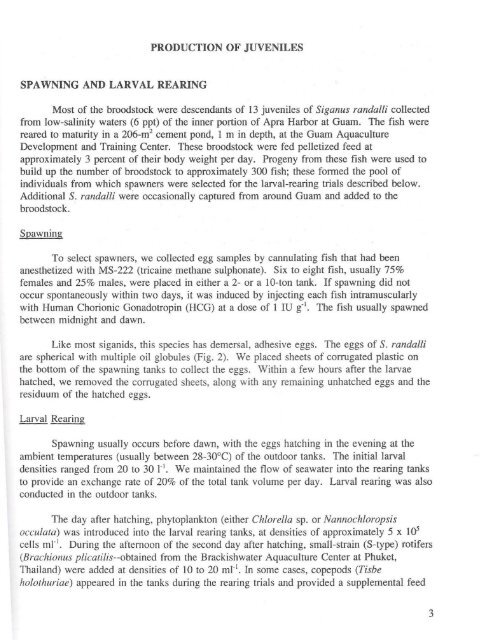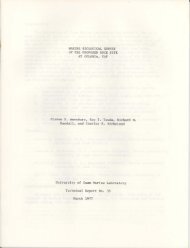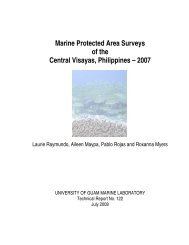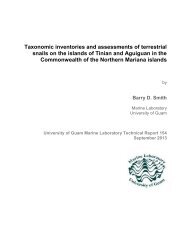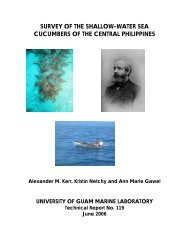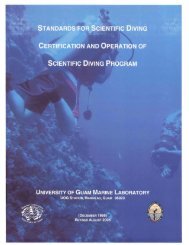Growth of the rabbitfish Siganus randalli Woodland - University of ...
Growth of the rabbitfish Siganus randalli Woodland - University of ...
Growth of the rabbitfish Siganus randalli Woodland - University of ...
- No tags were found...
Create successful ePaper yourself
Turn your PDF publications into a flip-book with our unique Google optimized e-Paper software.
PRODUCTION OF JUVENILESSPAWNING AND LARVAL REARINGMost <strong>of</strong> <strong>the</strong> broodstock were descendants <strong>of</strong> 13 juveniles <strong>of</strong> <strong>Siganus</strong> <strong>randalli</strong> collectedfrom low-salinity waters (6 ppt) <strong>of</strong> <strong>the</strong> inner portion <strong>of</strong> Apra Harbor at Guam. The fish werereared to maturity in a 206-m 2 cement pond, I m in depth, at <strong>the</strong> Guam AquacultureDevelopment and Training Center. These broodstock were fed pelletized feed atapproximately 3 percent <strong>of</strong> <strong>the</strong>ir body weight per day. Progeny from <strong>the</strong>se fish were used tobuild up <strong>the</strong> number <strong>of</strong> broodstock to approximately 300 fish; <strong>the</strong>se formed <strong>the</strong> pool <strong>of</strong>individuals from which spawners were selected for <strong>the</strong> larval-rearing trials described below.Additional S. <strong>randalli</strong> were occasionally captured from around Guam and added to <strong>the</strong>broodstock.SpawningTo select spawners, we collected egg samples by cannulating fish that had beenanes<strong>the</strong>tized with MS-222 (tricaine methane sulphonate). Six to eight fish, usually 75%females and 25% males, were placed in ei<strong>the</strong>r a 2- or a lO-ton tank. If spawning did notoccur spontaneously within two days, it was induced by injecting each fish intramuscularlywith Human Chorionic Gonadotropin (HCG) at a dose <strong>of</strong> I IU g.'. The fish usually spawnedbetween midnight and dawn.Like most siganids, this species has demersal, adhesive eggs. The eggs <strong>of</strong> S. <strong>randalli</strong>are spherical with multiple oil globules (Fig. 2). We placed sheets <strong>of</strong> corrugated plastic on<strong>the</strong> bottom <strong>of</strong> <strong>the</strong> spawning tanks to collect <strong>the</strong> eggs. Within a few hours after <strong>the</strong> larvaehatched, we removed <strong>the</strong> corrugated sheets, along with any remaining unhatched eggs and <strong>the</strong>residuum <strong>of</strong> <strong>the</strong> hatched eggs.Larval RearingSpawning usually occurs before dawn, with <strong>the</strong> eggs hatching in <strong>the</strong> evening at <strong>the</strong>ambient temperatures (usually between 28-30°C) <strong>of</strong> <strong>the</strong> outdoor tanks. The initial larvaldensities ranged from 20 to 30 \"' . We maintained <strong>the</strong> flow <strong>of</strong> seawater into <strong>the</strong> rearing tanksto provide an exchange rate <strong>of</strong> 20% <strong>of</strong> <strong>the</strong> total tank volume per day. Larval rearing was alsoconducted in <strong>the</strong> outdoor tanks.The day after hatching, phytoplankton (ei<strong>the</strong>r Chlorella sp. or Nannochloropsisocculata) was introduced into <strong>the</strong> larval rearing tanks, at densities <strong>of</strong> approximately 5 x lOscells mI·'. During <strong>the</strong> afternoon <strong>of</strong> <strong>the</strong> second day after hatching, small-strain (S-type) rotifers(Brach ion us plicalilis--obtained from <strong>the</strong> Brackishwater Aquaculture Center at Phuket,Thailand) were added at densities <strong>of</strong> 10 to 20 m\" '. In some cases, cope pods (Tisbeh%lhuriae) appeared in <strong>the</strong> tanks during <strong>the</strong> rearing trials and provided a supplemental feed3


